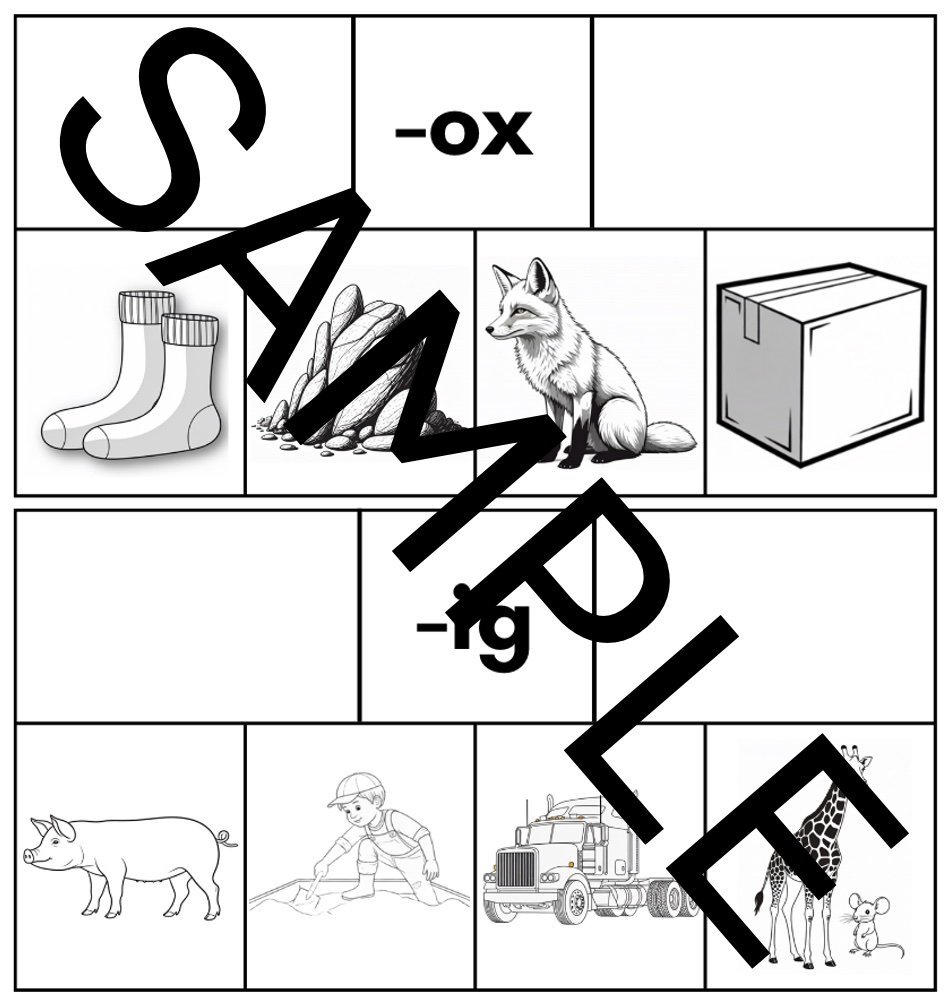Word Family Houses
Learning to rhyme is an essential early phonological awareness skill that we teach our preschool students. Since most of our students benefit from explicit instruction, this activity will guide them from recognizing onset-rime patterns to independently generating rhymes.
About This Packet
Included in this packet are: two houses, pictures for -et words, pictures for -ag words, pictures for -at words, pictures for-in words, pictures for -ox words, pictures for -in words.
Suggested Activities
Begin with one house an one set of words. Teach the words and task, because the pictures are not all obvious to children an have them place the words on the windows. Tell them this is my -ag house and all of my words soon like -ag.
Do this again but this time teach the task. Say, “W -ag makes the word ____. That’s right all of my words soon like -ag. Let’s do another b -ag makes the word ____. “
Find the one that doesn’t belong. Have the child close their eyes. Put one -et word on one of the windows and the rest -ag words. Go through all of the words, w -ag, b-ag, r -ag, v -et. Ask which one doesn’t sound like -ag
Keep practicing steps one through three until the child gets it. When ready move on to sorting between two houses. Make sure to start with sounds that are different so they don’t get confused. Start with the sets that are printed together on the same page.
Learning to rhyme is an essential early phonological awareness skill that we teach our preschool students. Since most of our students benefit from explicit instruction, this activity will guide them from recognizing onset-rime patterns to independently generating rhymes.
About This Packet
Included in this packet are: two houses, pictures for -et words, pictures for -ag words, pictures for -at words, pictures for-in words, pictures for -ox words, pictures for -in words.
Suggested Activities
Begin with one house an one set of words. Teach the words and task, because the pictures are not all obvious to children an have them place the words on the windows. Tell them this is my -ag house and all of my words soon like -ag.
Do this again but this time teach the task. Say, “W -ag makes the word ____. That’s right all of my words soon like -ag. Let’s do another b -ag makes the word ____. “
Find the one that doesn’t belong. Have the child close their eyes. Put one -et word on one of the windows and the rest -ag words. Go through all of the words, w -ag, b-ag, r -ag, v -et. Ask which one doesn’t sound like -ag
Keep practicing steps one through three until the child gets it. When ready move on to sorting between two houses. Make sure to start with sounds that are different so they don’t get confused. Start with the sets that are printed together on the same page.
Learning to rhyme is an essential early phonological awareness skill that we teach our preschool students. Since most of our students benefit from explicit instruction, this activity will guide them from recognizing onset-rime patterns to independently generating rhymes.
About This Packet
Included in this packet are: two houses, pictures for -et words, pictures for -ag words, pictures for -at words, pictures for-in words, pictures for -ox words, pictures for -in words.
Suggested Activities
Begin with one house an one set of words. Teach the words and task, because the pictures are not all obvious to children an have them place the words on the windows. Tell them this is my -ag house and all of my words soon like -ag.
Do this again but this time teach the task. Say, “W -ag makes the word ____. That’s right all of my words soon like -ag. Let’s do another b -ag makes the word ____. “
Find the one that doesn’t belong. Have the child close their eyes. Put one -et word on one of the windows and the rest -ag words. Go through all of the words, w -ag, b-ag, r -ag, v -et. Ask which one doesn’t sound like -ag
Keep practicing steps one through three until the child gets it. When ready move on to sorting between two houses. Make sure to start with sounds that are different so they don’t get confused. Start with the sets that are printed together on the same page.


